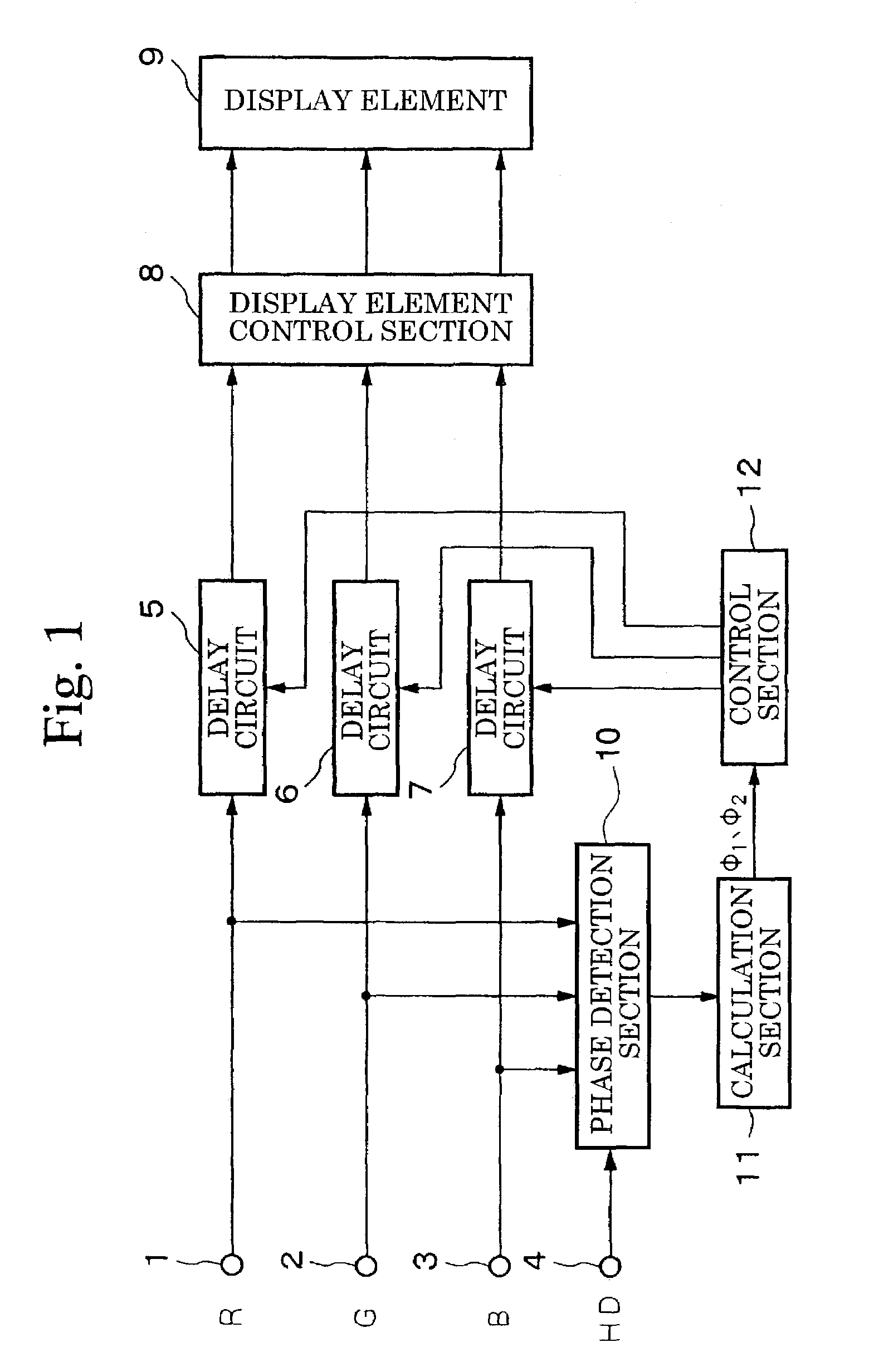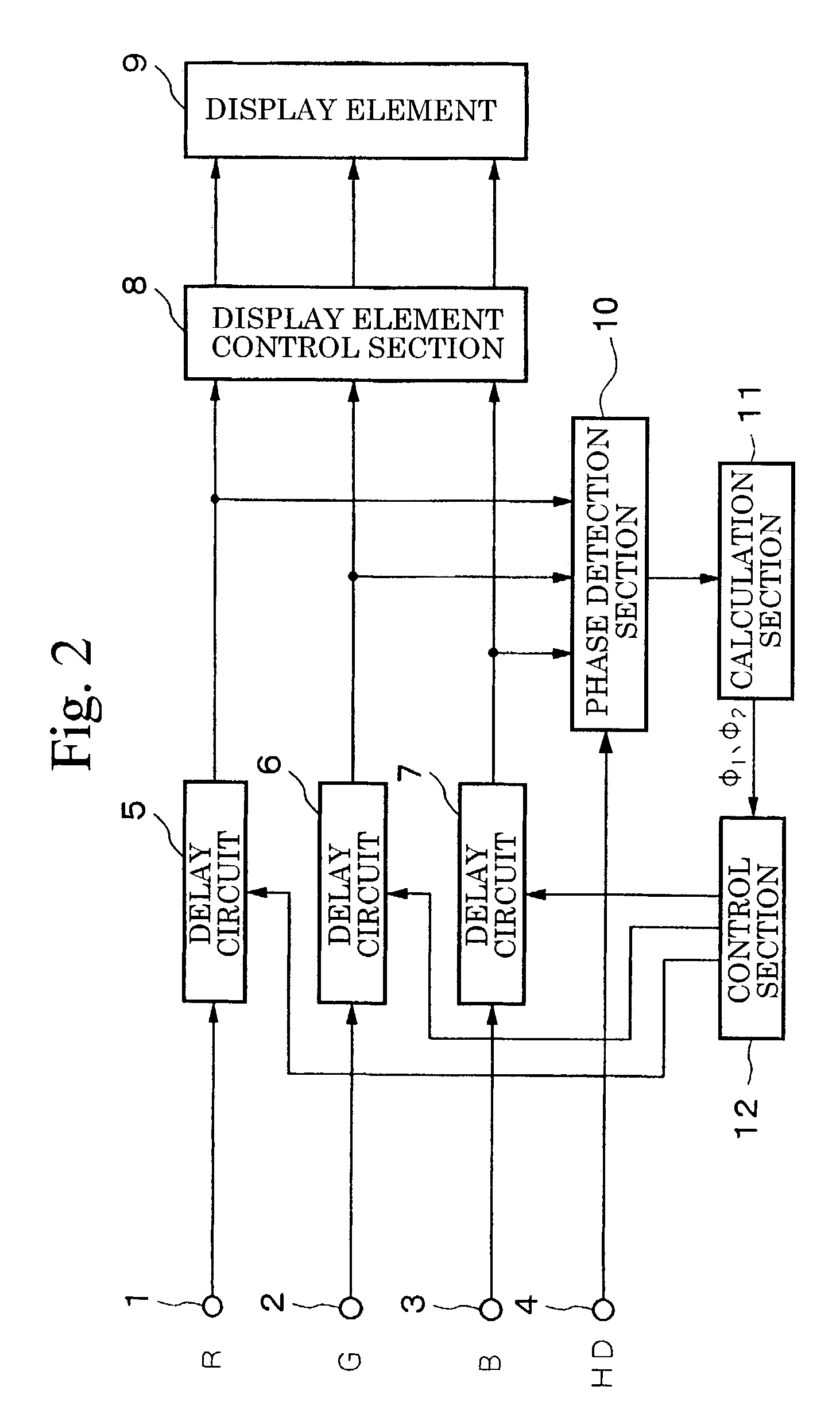Display apparatus
a technology of display apparatus and display screen, which is applied in the field of display screen, can solve the problems of long cable use, phase difference generation between r, g, b signals, and failures to occur such as parts of the end of displayed characters becoming colored, and achieve the effects of simplifying circuit structure, short period of time, and reducing phase correction amoun
- Summary
- Abstract
- Description
- Claims
- Application Information
AI Technical Summary
Benefits of technology
Problems solved by technology
Method used
Image
Examples
first embodiment
[0019]FIG. 1 is a block diagram showing the structure of the display apparatus according to the present invention.
[0020]In FIG. 1, the symbol 1 indicates an input terminal that receives the input of R signals from a PC (not shown) serving as a signal source, the symbol 2 indicates an input terminal that receives the input of G signals also from a PC, and the symbol 3 indicates an input terminal that receives the input of B signals also from a PC. The symbol 4 indicates an input terminal that receives the input of horizontal synchronization signals HD also from a PC. The symbol 5 indicates a delay circuit having a variable delay amount that delays input R signals, the symbol 6 indicates a delay circuit having a variable delay amount that delays input G signals, and the symbol 7 indicates a delay circuit having a variable delay amount that delays input B signals. The symbol 8 indicates a display element control section that converts the delayed R, G, B signals into display signals of ...
second embodiment
[0027]FIG. 2 is a block diagram showing the structure of the display apparatus according to the present invention, and the same descriptive symbols are given to portions that correspond to portions in FIG. 1 and a description thereof is not repeated.
[0028]The above described first embodiment shown in FIG. 1 employs a feed forward control mode in which a phase detection section 10 is provided upstream from the delay circuits 5, 6, and 7, and the delay amount of each delay circuit is controlled by detecting the phases of the R, G, B signals input from the PC serving as a signal source. However, the present embodiment employs a feed back control mode in which, as is shown in FIG. 2, the delay amounts of the respective delay circuits 5, 6, and 7 are controlled with the phase detection section 10 provided downstream from the delay circuits 5, 6, and 7.
[0029]Next, the operation of the above structure will be described.
[0030]In an initial state, the delay amounts of the respective delay ci...
third embodiment
[0032]FIG. 3 is a block diagram showing the structure of the display apparatus according to the present invention, and the same descriptive symbols are given to portions that correspond to portions in FIG. 1 and a description thereof is not repeated.
[0033]In the present embodiment, as is shown in FIG. 3, the delay circuit 5 is formed by an analog delay circuit 5A and a digital delay circuit 5B, the delay circuit 6 is formed by an analog delay circuit 6A and a digital delay circuit 6B, and the delay circuit 7 is formed by an analog delay circuit 7A and a digital delay circuit 7B.
[0034]The delay amounts of the analog delay circuits 5A, 6A, and 7A are analog controlled by the control section 12 as delay amounts of less than 1 dot (i.e., pixel). The delay amounts of the analog delay circuits 5B, 6B, and 7B are digitally controlled in 1 dot units based on dot clocks by the control section 12 as delay amounts of 1 dot or more. A PLL circuit 12A that generates dot clocks by operating on th...
PUM
 Login to View More
Login to View More Abstract
Description
Claims
Application Information
 Login to View More
Login to View More - R&D
- Intellectual Property
- Life Sciences
- Materials
- Tech Scout
- Unparalleled Data Quality
- Higher Quality Content
- 60% Fewer Hallucinations
Browse by: Latest US Patents, China's latest patents, Technical Efficacy Thesaurus, Application Domain, Technology Topic, Popular Technical Reports.
© 2025 PatSnap. All rights reserved.Legal|Privacy policy|Modern Slavery Act Transparency Statement|Sitemap|About US| Contact US: help@patsnap.com



